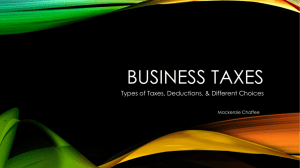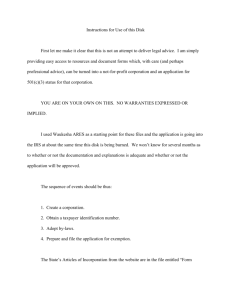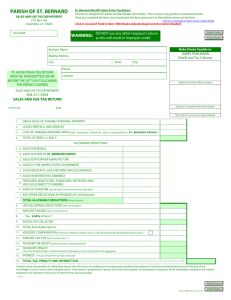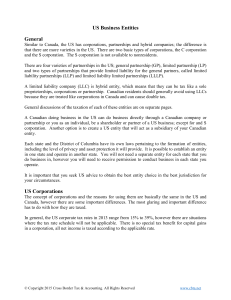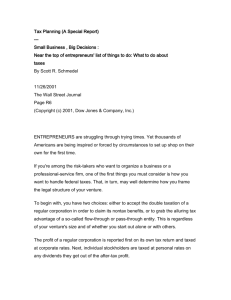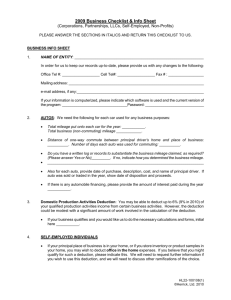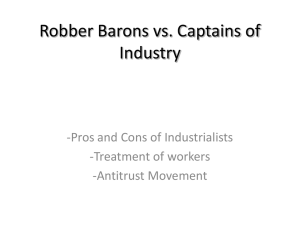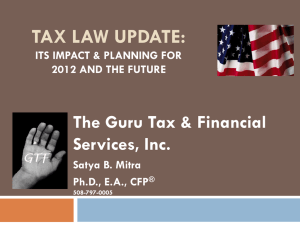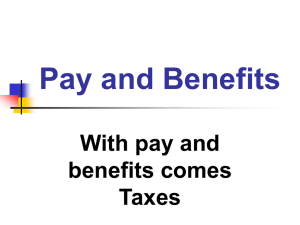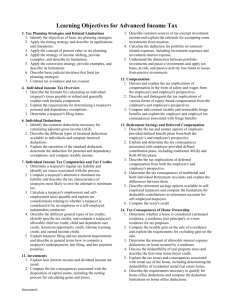Cathy Mitchell - Wichita State University
advertisement
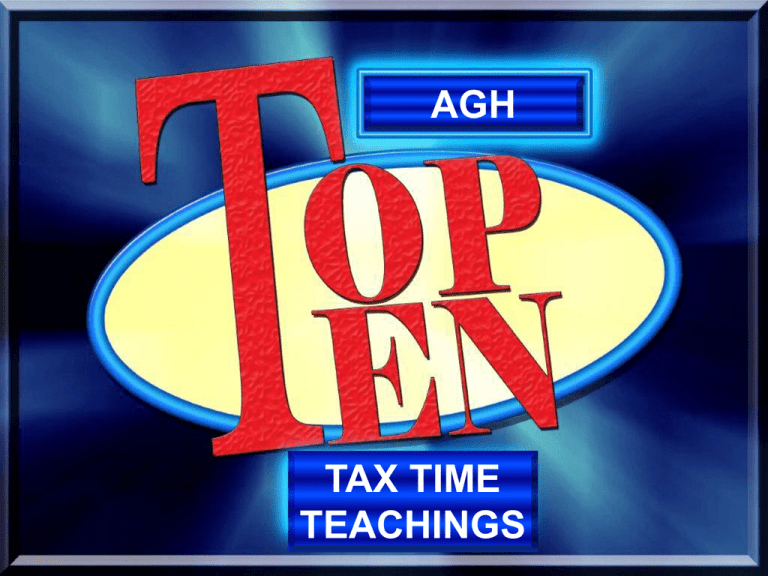
AGH TAX TIME TEACHINGS AGH Top Ten • A suite of web-based products that allow users to conduct business with the IRS electronically • Online tools available: • Tax return transcripts • Tax account transcripts • Taxpayer ID number matching • 2848s no longer allowed to be submitted via E-services • Research and development credit – To be extended again along with its simplified method • IC-DISCs – An export tax incentive in the form of permanent tax savings on the commission • Micro-captive insurance companies – Only insure the risks of their owners via a contingency fund built with pre-tax dollars • Windsor v. United States (same-sex couples) • Ruling applies to all provisions where marriage is a factor federal tax • Applies regardless of whether the couple lives in a state that recognizes same-sex marriage or not • For KS, joint returns not allowed for same-sex couples Frank Aragona Trust v. Commissioner (Trustee and nonpassive flow-through entities) • Trust held and developed rental and other real estate properties • Services performed by the individual trustees on behalf of the trust were considered personal services performed by the trust. • PAL limitations and NIIT not applicable Joanne Wandry v. Commissioner (fixed-dollar formula clauses in estate planning) • Shifts the valuation burden somewhat to the IRS • No stated % transferred • Rather, shares/units transferred which equal a set value • Marginal rates can approach 50% • Deductions to consider: • Home office • Tax preparation fees • Business use of cell phones • Related for-AGI deductions: • Self-employed health insurance premiums • Retirement plan contributions For closely held C corporations: • C corporation income is taxed twice: Once when earned at the corporate level, and again when paid as dividends at the shareholder level. Thus, they tend to pay large salaries, resulting in one level of taxation. IRS might reclassify as disguised dividends. • Courts consider 5 Elliotts’ factors: Employee role, comparisons to other companies, condition of the company, internal consistency of compensation, and consideration by hypothetical independent investor. For S corporations: • Compensation is subject to payroll taxes; K-1 pass-through profits are not. • Compensation is subject to income tax; distributions aren’t. • Kansas law changes make distributions even more attractive than W2 income. • Courts consider 5 Elliotts’ factors here, too. • Estimated as 28% of portfolio assets! • Some alternative investments: • Master Limited Partnerships • Publicly Traded Partnerships • Option trading and futures contracts Tangible Asset and Repair Study (TARS) • Impact any business that acquires, produces, or improves property, regardless of size • Safe harbors for small taxpayers (STSH) • AFS, UOP, RMSH, BAR – a few common acronyms to know • Cost segregations studies are useful. • Paid on the lesser of net investment income (NII) or the amount by which modified AGI exceeds a threshold • NII EQUALS • Interest, dividends, annuities, royalties, and rents, PLUS • Income from a business that is (1) passive or (2) trades in financial instruments and commodities, PLUS • Net gain attributable to the disposition of certain property (generally passive) LESS • Deductions (after other limitations such as the 2% floor and itemized deductions “haircut”) such as investment interest expense, investment expenses, state and foreign income taxes, and other properly allocable deductions Ways to Reduce NII • Investing in tax-exempt investments, gifting, and maximizing retirement plan contributions • Increase involvement in passive activities or group them with nonpassive ones Grouping of activities under Sec. 469 • A one-time regrouping is allowed in the first year in which a taxpayer has both NII and MAGI in excess of threshold. • Activities may be grouped into a single activity if they comprise an appropriate economic unit based on 5 factors. • Benefit of this regrouping is that it makes it easier to satisfy the 500-hour test and be nonpassive with regard to the entire group which is considered a single activity. Three hoops to deducting flow-through entity losses: Basis At-risk basis • Code Sec. 465 limits a taxpayer’s deductible loss to the amount at risk (loss of $) with respect to an activity • Form 6198 PAL rules • S Corporations • Are pass-through entities with income taxed once • Are tax-efficient whether the owners want to sell or retain their ownership through retirement and management transition • C corporations incur a double tax • Despite year-to-year being similar, there are tax benefits upon sale of an S corporation over a C corporation. • Even in a stock transaction, C corporation owners pay more tax than S corporation owners. • A potential BIG tax would be a consideration in making the S election. Cathy Mitchell Manager, Corporate Finance Services Allen, Gibbs & Houlik, L.C. Cathy.Mitchell@aghlc.com (316) 267-7231 Circular 230 Disclosure Pursuant to federal regulations imposed on practitioners who render tax advice ("Circular 230"), we are required to inform you that any discussion of tax matters contained herein (including any attachments unless expressly stated otherwise) is not intended or written to be tax advice, and cannot be relied upon as such, nor can it be used for the purpose of: (i) avoiding tax penalties that may be imposed by the IRS or states, or (ii) promoting, marketing or recommending to another party any transaction or matter addressed herein. If you seek definitive tax advice on a matter, please request a written tax memorandum from your AGH tax advisor.
